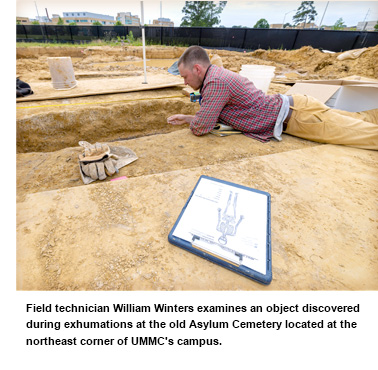Understanding our Past… Serving our Future
Good morning.
As I promised in a previous VC Notes, I would like to share more updates on the Asylum Hill Project, a multi-institutional effort that will provide a dignified final resting place and memorial for state asylum residents who are buried on the northeast corner of our campus.
This project, which also creates a resource for multidisciplinary research and education, gained even greater traction this year when the Mississippi Legislature passed a bill expanding access to old state asylum records. More on that later.
 The Asylum has a fascinating, and often difficult, history. Between 1855 and 1935, our campus was the site of the Mississippi State Lunatic Asylum and its cemetery. When the facility was constructed in 1855, it was state of the art; in other ways, though it was of its time and place: segregated by race and indicative of persistent health and treatment disparities. The Asylum permanently closed after patients were moved to the new facility, the Mississippi State Hospital at Whitfield, in March of 1935.
The Asylum has a fascinating, and often difficult, history. Between 1855 and 1935, our campus was the site of the Mississippi State Lunatic Asylum and its cemetery. When the facility was constructed in 1855, it was state of the art; in other ways, though it was of its time and place: segregated by race and indicative of persistent health and treatment disparities. The Asylum permanently closed after patients were moved to the new facility, the Mississippi State Hospital at Whitfield, in March of 1935.
While many assume that patients were simply abandoned at the Asylum and left to die, new research shows a more complicated story. Because of the Mississippi climate, patients were usually buried within 24 hours of death. Communication and transportation challenges often meant burial in the on-site cemetery was most expedient. Patient remains were sometimes reclaimed weeks or months after burial. The graves were originally marked carefully with wooden markers but they deteriorated over time.
About 10 years ago, the existence of the Asylum Cemetery was “rediscovered” when a road construction crew accidentally uncovered coffins on the north side of campus. Soon, archaeological teams from Mississippi State University and the University of Mississippi defined, through magnetic gradiometry, the approximate boundary of the cemetery.
The remains of about 7,000 people lie just beneath the surface of the only undeveloped part of the main campus.
Dr. Ralph Didlake, director of the Center for Bioethics and Medical Humanities, now leads a group of scholars which form the Asylum Hill Research Consortium. This group has engaged descendants, conducted public programming and is now involved with the ongoing exhumations and respectful management of human remains. This work will allow the Medical Center to continue growing, for the benefit of our present and future patients.
Almost 150 relatives of patients from the old asylum have contacted the AHRC and their stories are being recorded. While many descendants expressed unease about disturbing a cemetery, the potential for identification and possible return of remains to families began to balance out their concerns.
Here are some of the project’s recent progress updates and findings:
- An excavation team has exhumed at least 150 burials since mid-November.
- Most exhumed individuals are adults, but two teenagers and one child have also been recovered.
- Records indicate there were at least 180 burials of people age 18 and younger. Many of the younger patients had then-untreatable conditions such as epilepsy.
- Some personal items have been retrieved, including a ring with an inscription (but no name) and a hair comb.
- The Asylum Hill Archaeological Field School, with about 20 students from across the country, is scheduled to begin in July. These are graduate and undergraduate students studying archaeology, forensics and anthropology.
Recently, the Mississippi Legislature re-appropriated the unexpended fund balance of the original $3.67 million outlay for the project, and the governor signed into law SB 2797 to clarify custody and use of the pre-1935 Asylum records. Once they are organized and identifying information is removed, the records will offer a trove of details about treatment in the old asylum.
I am extremely grateful for what our state lawmakers have done to keep this valuable work moving ahead, and I want to express my thanks to those who have contributed to this project. As with so much of our work at the Medical Center, and as I have so often said, we need everyone’s commitment and help – across all of our endeavors – to propel us toward our goal of A Healthier Mississippi.



